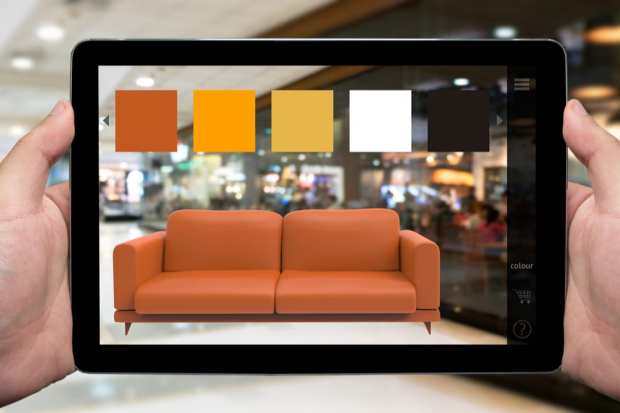AR’s Role In eCommerce Is Growing (And Will Likely Outlast The Pandemic)

As consumers increasingly move to digital commerce in the wake of COVID-19, augmented reality (AR) technology is appearing in various applications as retailers rush to best replicate the physical shopping experience in an entirely virtual context.
The latest entrant into this growing market is eCommerce’s 800-pound gorilla — Amazon. The eCommerce giant is rolling out a new AR shopping tool called “Room Decorator,” TechCrunch reports. The tool allows shoppers to virtually place home decor items into photos of their existing spaces to get a better feel for how the goods will look if actually purchased.
IKEA and Wayfair also offer similar AR products, and Amazon has actually had a version of AR shopping available since 2017. But what makes Room Decorator unique is that it’s not limited to showing shoppers a single product at a time. Consumers can add multiple objects to their rooms to better visualize how a whole host of new products would fit together.
Room Decorator will even supply shoppers who place a single item in their spaces with suggestions of complementary additional products. If the customer is ready to purchase, Room Decorator will add all selected items into a shopping cart from within the AR experience.
The tool also allows users not yet ready to buy to save their augmented images for later reference in a newly created section of their Amazon accounts called “Your Rooms.”
“Amazon is always exploring new ways to create experiences that delight our customers,” an Amazon spokesperson told TechCrunch. “With the addition of Room Decorator tools, Amazon enhances its augmented reality feature to give customers an even more immersive shopping experience from the comfort of their own home or on the go.”
But Amazon is far from the only player expanding its AR offerings in light of the great digital commerce reset currently underway. Fashion has become a particular center of activity, as many consumers still want to try things on before purchasing them.
Embedding AR into digital retail can satisfy that interest to an extent. For instance, Gucci has released both its own AR and recently partnered with Snapchat to make it easier for users to “try on” eight of its shoes virtually.
Chinese eCommerce power player JD.com also recently rolled out an AR feature that gives customers the option of trying on more than 1,000 sneakers on the platform. To further enhance virtual shoe try-ons, JD also announced it’s working with Sony to develop AR tools that will allow consumers to measure their shoe sizes using their smartphones.
CEO Jon Cheney of AR firm Seek recently told PYMNTS that the technology’s relevance is only going to grow as merchants look for digital paths to walk on toward a recovery. He said furniture is the obvious first use case, but that as the fashion world has recently started demonstrating, there are many, many others out there as well.
Cheney said consumers might be able to go back to stores as lockdowns ease, but that doesn’t mean they actually want to. And until they do, smart retailers will develop more advanced digital options to enable comfortable shopping experience, he said.
“There’s going to be this wave of consumers going out just because they can in the beginning — but then people are going to reconsider the necessity of going out,” Cheney predicted. “People are going to ask themselves, ‘Can I buy this from home? Do I need to go out right now?’”
He said consumers’ thinking about shopping from home will be similar to what they think about working from home or ordering food delivered there.
“I think a lot of it comes down to basic changes,” Cheney said. “Look at Grubhub and other remote technologies that bring food to the consumer instead of the consumer going out for food. That’s an example of something that will stick.”
He believes AR will stick as well — not necessarily as a replacement for the physical store, but as an enhancement to it. That’s a sentiment increasingly shared by retailers that have leaned into AR expansions.
For instance, Glossy reports that sunglasses brand Bolle recently rolled out its AR based “Try-On, Try-Out” feature that allows consumers to try on certain sunglasses frames. It also lets them to get a feel for what the world will look like through the sunglasses.
Chris Abbruzzese, Bolle’s vice president of trade marketing for North America, told the site that addition has already made a notable difference in consumer behavior.
“We’re seeing more time spent on site, from one to two seconds to 12 to 13 seconds,” Abbruzzese said. “We’ve created an expectation for performance sunwear that’s going to come back to bite us, because now for everything we release, we’re going to have to have the ‘Try-On, Try Out.’ But we’re headed down that road now.”
And according to Seek CEO Cheney, a lot of retail will soon be heading down that road as the economy reopens and retailers look to widen the options they offer consumers.
“The potential diversity of use cases is interesting, particularly now that we’re talking about reopening the economy,” Cheney told PYMNTS. “I don’t know how comfortable consumers will be walking into any store to buy anything for a while. Having the ability to bring the commerce experience inside their homes where they can safely experience a product before they buy it — that’s the most relevant use case right now.”
